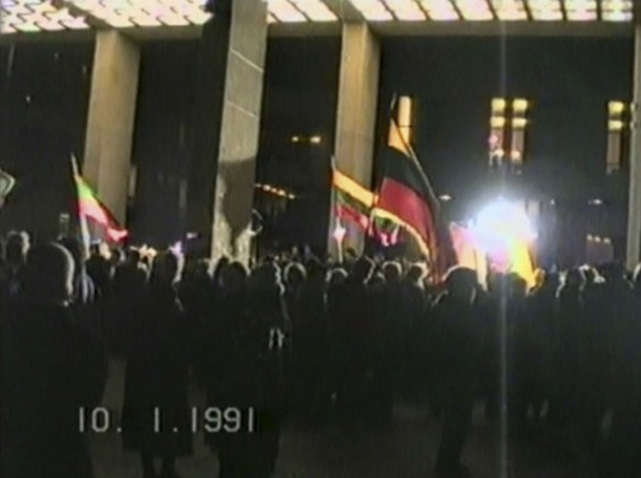
THE VOICE OF INTERNATIONAL LITHUANIA
|
VilNews has its own Google archive! Type a word in the above search box to find any article.
You can also follow us on Facebook. We have two different pages. Click to open and join.
|
NEW VIDEOS:
Cold War eyewitnesses
come forward

Eyewitnesses at the Lithuanian Parliament in Janaury 1991.
Photo by Albinas Kentra.
The main objective of the new BALTIC INITIATIVE and NETWORK is to strengthen mutual understanding between the countries around the Baltic Sea through an exchange of information on the Cold War period. The idea is that history should be told from the historically valuable sites at which events took place. Relevant sites include, for example: military installations and towns, prisons and prison camps, partisan bunkers, execution sites, secret police offices, sculptures and architecture or simple squares or buildings where memorable events took place.
While this information is normally handled by museums, they believe that recent history can be told effectively from these sites from the prospective of – it happened here - with the significant help of eye witnesses. Their main task up until now has been to initiate and participate in concrete, international activities and co-operation projects that can improve this mutual understanding. Their main activity thus far has been to support and participate in international cooperation projects that strengthen these activities.
“LISTEN TO THE EYE WITNESSES”
A part of the Baltic Initiative and Network’s sharing of information process is to publish videos based on eyewitness accounts. One special feature of recent history is that many eye witnesses are still alive and can provide important information on the history of events and on valuable historical sites. These are people who were present at the sites as prisoners, partisans, participants in demonstrations, dissidents, military staff etc.
Dear readers, we would like to share with you some of their very informative videos about Lithuania during the Soviet Russian occupation. All of these videos were produced by Algis Kuzmickas of Lithuania in 2011 for the Baltic Initiative and Network.
Jonas Kadzionis - The Partisan in the Forest.
Restored and reconstructed partisan Bunkers, Lithuania.
Jonas Kadzionis was a former partisan, GULAG prisoner and deportee. He has reconstructed the former underground bunker in which he hid throughout his partisan life.
Juozas Aleksiejunas - Prisoner in the KGB prison
The KGB prison
The Museum of Genocide Victims, Aukų gatvė. 2A, Vilnius.
Juozas Aleksiejunas is a former partisan who was arrested by the Soviet occupation forces in 1945. He was interrogated in the KGB prison in Vilnius.
Tomas Sernas - Survivor of the Border Massacre.
The Medininkai Memorial. Lithuania
At 4 o’clock in the morning on July 31, 1991, eight Lithuanian policemen and customs officers were executed in Medininkai, on the Lithuanian border with Belarus. They were killed by shots to the back of the head. The executers were Soviet OMON forces from Riga (Special armed police units). One of the border officers, Tomas Sernas, miraculously survived, albeit disabled. He had been working as a biologist in Kaunas Zoo at the time and felt that he had to do something for his newly independent country so he volunteered as a customs officer.
Vytautis Andziulis - Underground Printer
The secret Printing House. Kaunas, Lithuania
The secret “ab” Printing House was set up in 1979 by Vytautis Andziulis, a professional printer, and Juozas Bacevičius. The printing activities took place in the home of the Andziulis family, north of Kaunas. The printing house produced 138,000 copies of 23 different books, covering Lithuanian history, religion, philosophy and poetry. The printing house was never found by the secret police although there were some close calls.
Albinas Kentra - The camera as a weapon
The Sites of the Freedom Demonstrations. Vilnius. Lithuania
Albinas Kentra was a former partisan, GULAG prisoner and deportee. He is mostly known for his unique video footage of the bloody January events of 1991 in Vilnius when hundreds of thousands of Lithuanian people took to the streets in their newly independent country to protect key institutions from the Soviet military forces.
Gintautas Kazlauskas - Deported twice to Siberia.
Druskininkai Museum of Resistance and Deportations.
Gintautas Kazlauskas was deported to Siberia with his mother and little sister. His sister died because of the hard living conditions. Gintautas and his mother fled back to Lithuania but were arrested and deported once more. Following Lithuania’s independence, he returned to his fatherland after 42 years in exile. He is the founder and current director of and guide at the Druskininkai Museum of Resistance and Deportations.
Irene Spakauskiene - Deported children of the ice
Reconstructed Siberian Yurt. Rumsiskes, Lithuania
Irene Spakauskiene was deported to the Laptev Sea region with her family when she was a little girl. It was a region with permafrost and a temperature of up to minus 50 degrees. The stay was marked by cold, hunger, disease and death, which hit the old and the children first and foremost. The deportees lived in peat huts, so-called yurts. The windows were made of pieces of ice and the inside temperature never rose above freezing.
We would highly recommend you visit their web site http://coldwarsites.net/
It has a wealth of information about not only Lithuania and its Baltic neighbors Estonia and Latvia but also Denmark, Germany, Finland, Iceland, Norway, Poland, Russia and Sweden. This is a very informative site about a very worthwhile project.
Su pagarbe
Vincas Karnila
Associate editor
- Bookmark :
- Digg
- del.icio.us
- Stumbleupon
- Redit it
VilNews e-magazine is published in Vilnius, Lithuania. Editor-in-Chief: Mr. Aage Myhre. Inquires to the editors: editor@VilNews.com.
Code of Ethics: See Section 2 – about VilNews. VilNews is not responsible for content on external links/web pages.
HOW TO ADVERTISE IN VILNEWS.
All content is copyrighted © 2011. UAB ‘VilNews’.

 Click on the buttons to open and read each of VilNews' 18 sub-sections
Click on the buttons to open and read each of VilNews' 18 sub-sections 



[…] Cold War eyewitnesses come forward […]